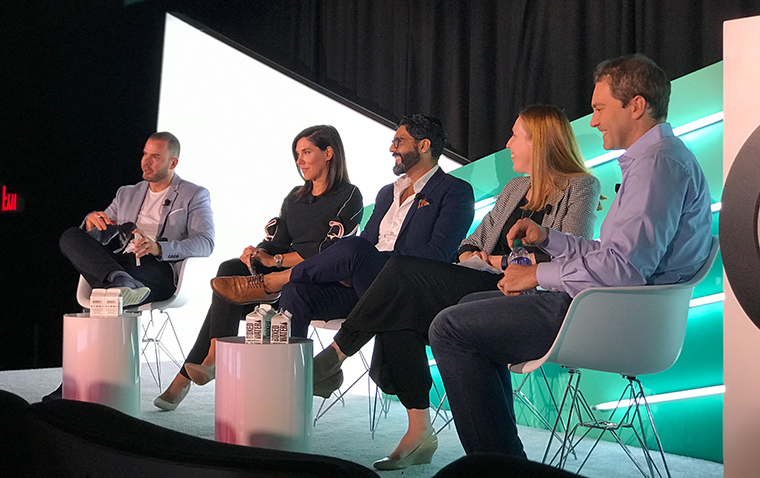The shift from brand safety to brand suitability
Brand safety is in the eye of the beholder. What is considered unsafe for one brand may be completely appropriate for another. As the advertising landscape continues to transform, there is no “one size fits all” approach. At Advertising Week New York, IAS Chief Marketing Officer Tony Marlow sat down with Disney, Neuro-Insight, Pandora, and Publicis Media Exchange to discuss the shift from brand safety to a broader concept: brand suitability. While a lot of effort has gone into understanding creative executions, significantly less effort has gone into understanding the broader environment where ads appear. Our panel sought to shine some light on the less-considered context of an ad.
Panelists:
- Maria Breza, Vice President, Data Operations & Ad Quality Measurement, Pandora
- Yale Cohen, Executive Vice President, Global Activation Standards, Publicis
- Lisa Valentino, Executive Vice President, Client & Brand Solutions, Disney
- Pranav Yadav, Chief Executive Officer, Neuro-Insight, US Inc.
Brand safety is the floor, brand suitability is the goal
As we begin the shift from brand safety to brand suitability, alignment on what it means to be “brand safe” is vital. Brand safety refers to content that is unsafe for every brand. According to Maria Breza at Pandora, technology should already be good enough to figure out which content is unsafe and flag it. Brand suitability, on the other hand, is more about what a brand stands for and finding the right content to fit those values.
For a mass media company like Disney, it’s table stakes. “As storytellers, we spend most of our time talking to our partners about how you become part of their stories and the experiences that we reflect on and tell every day,” says Valentino. “With a company built on consumer trust, you need the right technology partners.”
Brand safety comes down to perception. Neuro-Insight CEO, Pranav Yadav, offered a scientific explanation for this: because nothing exists in isolation, our perception of everything is influenced by the context in which we’re taking it in. According to Yadav, “Context and content is the marriage that everybody has to work with. One doesn’t exist without the other.” As a brand, the environment in which you are present is the biggest determiner of how you will be perceived by consumers. Therefore, weeding out universally unsafe content should be the first step for any brand seeking to avoid negative perceptions.
Brand suitability, however, is based on association rather than mere perception. Our brains function through association, and similar to the idea that we become the sum of the five people closest to us, brand perceptions are influenced by the context that they are most commonly associated with.
Looking ahead
To consider the future of brand suitability, the panel turned to science. “Every piece of media has an inherent neurostate,” Yadav explained. Research done by Neuro-Insight reveals the importance of aligning a brand’s state of mind with the media’s state of mind. Contextual advertising once meant matching an ad to content type, but now the focus should be on finding a match for the ethos of the creative. This, of course, comes with its own difficulties.
“For consumers, it’s a conversation about freedom of speech,” said Yale Cohen from Publicis. He noted that it becomes a question of what should be online, what brand’s opinions are, and how that should be placed within their ecosystem. Brands should strive to be around engaging content, but they need to designate risk tolerances to avoid exposing their consumer base to content that is hateful, controversial, or damaging.
And yet, according to Valentino, there are platforms failing at brand safety, and still profiting from the very advertisers who view brand safety as the bare minimum requirement. She says there is still work to be done: “There should be clear guidelines across platforms and publishers on what the floor actually is and what isn’t acceptable.”
Looking ahead, a mass media company like Disney, which is driven by storytelling and consumer trust, is now looking to have a more active role in content strategy. The key will be to find a balance between authenticity and driving content as the market shifts and so far, this approach has proved successful. Disney saw a 200% increase in search volume after integrating content in likable, suitable environments with a positive association.
From a music perspective, Pandora experiences different challenges than, say, a news environment. According to Breza, a lot needs to change from a technology perspective for a music company like Pandora to grow into the brand suitability space. Defining what brand safety actually looks like for brands within the music environment is likely the first hurdle. Pandora is hoping to see improvements in technology so we can understand more about the context of artistic content.
Collaboration across the industry
Now, brands are well aware of their brand identity and how they want to be perceived, but there is much more collaboration and sharing of thought leadership that needs to be done, Cohen explained. Most brands generally want to avoid fake news, and therefore lean on reputable organizations to keep their brand’s reputation safe. Unfortunately, it’s been noted that using this strategy on its own leads to neglect in risk tolerance.
All panelists agreed on one common thread: brand safety standards should be agreed upon by the industry as a whole. Once the industry is aligned, the foundation will be strong enough to advance together towards brand suitability by setting the proper risk tolerances to align their messaging with their desired audience and outcome.
 Share on LinkedIn
Share on LinkedIn Share on X
Share on X


